How I defied the odds to rapidly prepare for a grueling but liberating trek on foot around the most sacred mountain in the Himalayas
By Vidya Mohan, USA
I have never been an ardent devotee of Siva. I have never harbored strong aspirations for coming to Mt. Kailash. Yet, on a morning walk in September 2022, I felt a strong urge to go. Maybe it’s the subconscious working of many books and podcasts of spiritual seekers, or frustration driven by a lack of spiritual guidance. I hoped in desperation that an escape to these serene Himalayan surroundings would help me find a solution to my spiritual restlessness.
My family received my announcement with shock and laughter. Considering I could not climb a flight of stairs without panting, their concern stemmed from the reality of my fitness, or the lack of it. Also, Tibet had been shut down for tourism over the last few years, and it was unclear when the trek would reopen. The only entry ways into Tibet were through mainland China or via Nepal with a group tourist visa from an agency in Kathmandu. Despite this uncertainty geopolitical situation, I made a serious plan in March 2023 and paid my advance to Monterosa Travels, which I had shortlisted from my research.
I had resolved to go alone. I yearned for silence, not wanting to be burdened by anyone’s safety or comfort. It was a selfish feeling that I wouldn’t debate with anyone. I needed to conserve the energy to focus on myself and have a silent conversation with Siva.
Mt. Kailash is the second highest peak in the Kailash range, part of the older Trans Himalayan range. This sacred geography, where the Brahmaputra, Sutlej, Indus and Karnali rivers originate, is dear to Hindus, Jains, Buddhists and Bonpos (people practicing the indigenous Tibetan religion) alike. Since the Kailash range lies in the rain shadow of the Greater Himalayas, it is primarily dry and inhospitable. Out of respect to the sensibilities of the peoples of the subcontinent, climbing Kailash is prohibited, so it is experienced via a parikrama or kora, a path, around its base.
In the Pacific Northwest where I live, there aren’t many mountains that offer hikes at comparable altitudes to Mt. Kailash’s kora. I also wasn’t a seasoned hiker by any stretch, so with the basic essentials of hiking poles, boots and a hydration pack, I targeted about 2-3 hikes with moderate elevation every week. Plus daily walks of about four miles to build endurance, exercising caution to not exacerbate a recent ankle injury. During these treks, I built focus by inward chanting of slokas of Siva and listening to Sri Rudram. When I struggled, I propelled myself to keep moving by visualizing myself by the base of the mountain, hugging it, or sitting by the banks of Lake Manasarovar. These techniques later helped during the actual parikrama when despondency and exhaustion took over.
In parallel, I researched lightweight gear, taking inspiration from friends who skied or climbed. The tour agency had committed to providing a duffel bag and a small backpack and sent a helpful checklist for packing.
June came quickly, and I found myself in Kathmandu. This friendly, ancient city has a lot of culture that you can experience by visiting the bylanes of Boudhanath or the neighboring city of Bhaktapur. Its crowning glory, however, is the Pashupatinath temple, whose garbhagriha houses a four-faced Mukhalinga. Its sanctity is preserved with Agamic rituals by priests trained at the Sringeri Mutt in Karnataka. I made several visits to sit in the premises and participate in a brilliant arati over River Bhagmati at night.
Lhasa’s Gonggar airport was still closed, so we used the land-based route that took us through the towns of Kerung and Saga in Tibet. Given the size of our party, our visas were made available a few days after we appeared for biometrics, and we flew to the Nepal border on a clear Friday evening. The border offices were closed for the day, so we stayed at a small hotel in a nearby hamlet called Ghate Khola.
Walking along the roaring Trisuli River, I was moved by the sheer magnitude of the mountains. You don’t realize just how vast the Himalayan mountains are until you are there. Then it becomes easier to understand why, for centuries, restless seekers came purposefully to cloak themselves in anonymity, abandoning the comforts of security, warmth, sustenance and familiarity.
The next day we got clearance—after a seven-hour wait at the border and a thorough inspection of our possessions, including cell phones. The buses we boarded were equipped with CCTV, and there would be stops for passport inspection at various points. We looked forward in restless anticipation to reaching the banks of Manasarovar.
We spent that night at a hotel in Kerung and the next day drove towards Saga. At 4,500 meters in altitude, I became dizzy and breathless if I walked at my regular pace. Despite many of us being on Diamox medication, I heard murmurs of headache, nausea and sleeplessness all around. This served as an early warning for us to walk slowly, talk less, eat consistently to energize and drink more liquids. I bought an oxygen canister in Saga in the event of an unlikely emergency.
There were over sixty yatris, pilgrims, in my tour group. Even though we were strangers from different walks of life and ages, we were united by our bhakti for Siva and shared a strong excitement for this pilgrimage. Everyone was aware that they were on a special journey, perhaps the most meaningful of their entire life. The remoteness and inaccessibility of Kailash, complicated by the associated expenses and health risks, ensured that most people pushed it out towards the end of their lives, when they had fulfilled their dharmic duties towards family. While this reduced their chances of completing the parikrama, it ensured that they at least saw and felt the presence of this mountain once in their life, which a million others could not claim.
Lake Manasarovar
The bus arrived at Manasarovar on July 3rd, just 20 kilometers from Mt. Kailash. Our Tibetan guide announced that we were very lucky to have an unobstructed view of the mountain, so we all sprang out of our seats, clambering to leave the bus. The excitement was palpable as I ran towards the mountain. When the realization hit that this was a futile exercise, I sat down on the sand and closed my eyes. Nearly thirty minutes passed before I became aware of the lake nearby.
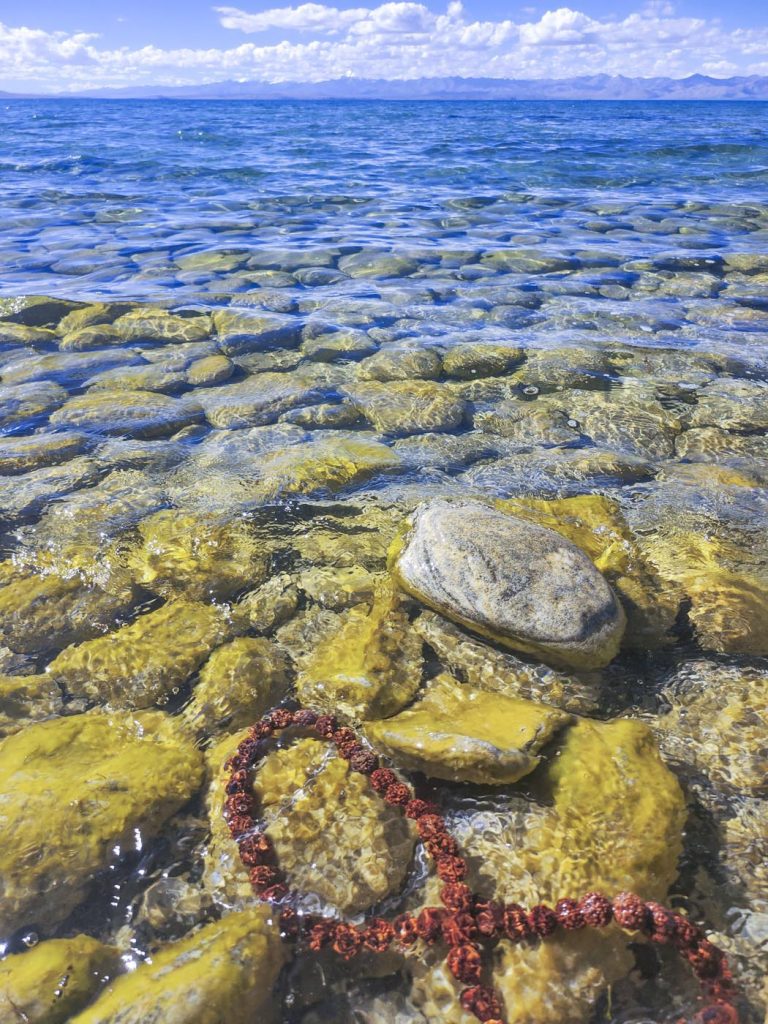

The blue water shimmering at a distance was the fabled Manasarovar mentioned in the Puranas: waters born out of the thoughts of Brahma, so special that mystical beings from other realms or lokas visit it every night. The roughly elliptical lake is ten miles wide and 16 miles long. Several of us have imagined and yearned for one dip in these alpine waters in our lifetimes, and suddenly it was near me. I could touch it, but not enter. The Chinese government has forbidden entering the lake since 2017, but we were told that we could bathe in its waters provided in buckets inside a makeshift tent the next morning.
We were housed in mud huts by the banks and served tea to bring relief to our bodies wearied by the travel and excitement. The lake was more crowded than normal on account of Guru Purnima that day. I was determined to nap and then get up later that night to soak in the moonlight, so I set up multiple alarms on my phone. However, by the unfortunate placement of my cot near the door, I couldn’t sleep, so I silently eased out from under my blanket, careful to not wake up the others in the dormitory. There is a strange onslaught of energy in these areas that just keeps one awake, as if priming us to meditate and not waste any moment sleeping. Along with two other yatris, I walked down to the lake where the staff had erected tents for meditation.
The moon shone really bright, overshadowing the stars in the sky. Alerted by a quick movement, I spotted the streak of a shooting star as it dissolved into the horizon. I briefly wondered if some devata had made their entrance on this grand stage. Puddles glistened bright, reflecting the moonlight. I turned off my headlamp, let my eyes accustom themselves to the darkness and felt myself melting into this frame. I occasionally spied a few birds on the vast expanse of the water. For a moment I was jealous of them as they were lucky to be able to dip and dance on its serene surface with abandon.
Minutes melted into hours. It was now well past midnight, and more yatris began streaming in. I began heading back and looked once again towards the mountain, now barely seeing it, and mentally thanked Siva for bringing me here. What made it special was that my birthday had just dawned by these banks and in His warm embrace—a moment that neither I nor anyone could have planned for in their lifetime.
I barely slept the remainder of the night and woke up with a searing headache. Relentless pain was shooting through in succession, with no relief provided by painkillers or a warm bath by the banks of the lake in a makeshift tent. Several others also slept poorly and suffered the crippling impact of altitude sickness.
I participated partly in the Rudra homam. As the fire smoked up, something the priest said struck me. He asked us when taking sankalpam to focus on ourselves. To focus on the relationship between us and the higher consciousness and not dilute our prayers by inviting family members and friends into our thoughts. We are lucky to be by these banks, he said. When the time is right, our children, spouse, parents and others, too, will make this journey. He also told us to keep our senses open, and not miss absorbing what happens around us. Even the winds have something meaningful to say, he asserted, and we must be ready to listen. For my wearied self, it was a call to focus on the moment. To quiet the ego, grow deeper into silence and surrender to this vastness.
After brunch, I packed my bag in preparation for the next leg of the journey. An important decision at this point was whether we would employ a porter to carry our day pack or hire a pony to ride upon for the parikrama, circumambulation. Considering today’s weakened condition, there was no doubt in my mind that I needed a porter. Already several members were calling off the parikrama as the altitude’s impact depleted their energies and made it difficult to even walk a few steps without support. The mood was grim and uneasy as we piled into the bus towards Darchen, the base camp.
Day One of Circumambulation
We awoke early the next day and bundled into the bus towards Yama’s Gate, a 10’ by 10’ shrine that is the traditional entry for pilgrims. Porter and pony assignments were made here through lotteries. Tibetans of both genders came in from remote villages to participate. They make a princely sum carrying the bags of yatris. Their petite bodies are endowed with strong lungs and muscles that effortlessly carry several kilograms of weight. I was delighted to learn that one of the Nepalese staff in my crew, Mani, was elected to be my sherpa. This made it easier for me to converse in Hindi.
Mani effortlessly hauled my day pack, which I had nervously overstuffed that morning, and we were ready to begin our four-day journey together. As was the custom in those parts, I executed three circumambulations around Yama’s Gate, sought the blessings of the Hindu pantheon of Brahma, Vishnu and Siva for a safe passage, rang the bell above my head and marched through its cluttered gateway, not looking back once.
On the first day, yatris start at the southern side and walk clockwise around to Dirapuk, close to the northern face of Kailash. This was a distance of a little over six miles that could be covered with a gentle amble except for some steep sections at the end. Mani could tell when I had trouble talking and refrained from engaging me in conversation. He became adept at watching my face for any sign of struggle, guiding me to a rock to rest or offering me the water bottle.
The kitchen staff had provided snacks and hot water that morning. This route is accessible by emergency vehicles, and we had to step away once in a while to let them pass. That day would determine how many would continue the circuit. Nestled in the bare mountains, we walked upon sandy trails by the river as it rushed and sprang delightfully on one side. There was no tree cover, so all bio breaks were executed behind rocks. My throat and nostrils were dry, given the continuous onslaught of the wind. I chided myself for not packing any nasal spray, as the dry nasal lining bled, making it harder to breathe. Occasionally we would encounter a Tibetan tea house that provided an opportunity for us to rest or refill hot water upon payment.
The day stretched on. I took breaks leaning on my poles, as sitting down and getting up felt like more effort. The sharp sound of the rain and hail as it struck against my plastic poncho, interrupted by the heaviness of my breathing, cut off the rest of the world for me. It was difficult to focus on anything beyond my next step. My extremities were getting wet and cold, and I hoped at every turn I would be gifted with a sight of the Dirapuk monastery where we would overnight.

After what seemed like a long day, Mani finally nudged me and pointed to a building across the road. Even though it wasn’t far away, it took another 20 minutes to get there. By then the rain came in harder and I was shivering in the cold. More than six hours after I started, I finally dragged myself into the dormitory where we would spend the night. It was directly across from the north face of Kailash, often considered its most beautiful, but that evening it was hidden by a thick cloud cover.
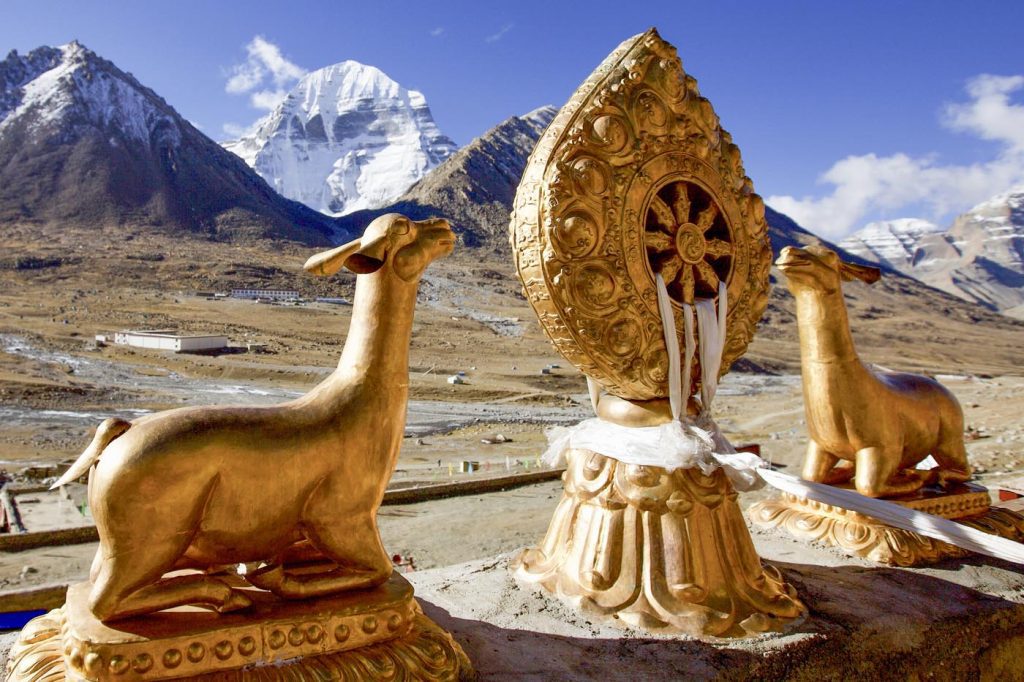
Several were returning to Darchen as their symptoms were concerning. Sleep was still elusive, and I finally slid out of bed at 2am. The weight of the electric heated blankets helped more than the meager warmth they provided. There were no restrooms in the building; we had to walk to a public restroom or use the natural outdoors. Power supply was restricted to a few hours in the evening, so it was very dark. Aided by my headlamp, I gingerly made my way down the stairs, clutching the railing.
The rain had stopped and the night was quiet. I could see the silhouette of the mountain right outside, nestled against the stars. It felt deceptively close, as if I could reach out and touch its surface, but I knew we were separated by several hours of hiking at the very least. It was a beautiful silence, interrupted briefly by the ebb and flow of thoughts of how the next few days would unfold. Kailash stood still, as if reassuring me with its presence while demanding complete surrender. I smiled and turned back to catch what little sleep I could.
Day Two
The next day, at least 15 of us were ready to walk towards the mountain. We were not certain if we would make it close, as the previous batch were turned back from Dirapuk given the weather conditions. The patches of green on either side of the steep trail were strangely comforting, in contrast to the grayness all around me. Icy water that had just melted off the glacier on Kailash was flowing down in streams. The trail was becoming more slippery and disappeared completely after a point, as the ground gave way to fields of loose gravel. My pole struck a hard surface, and when I pushed against it, I noticed streaks of white dirty ice below the layer of gravel.
The senior guides plowed ahead to see whether we would be able to get close to the mountain. It was a 2.8-mile trek which got harder as we got close to it, and my pace slowed considerably. I reached mounds of ice underneath a thick layer of rocks and sought assistance of two porters to haul me up. I remember feeling desolate as each physical challenge exposed my helplessness.
A light snowfall rendered a magical feel to the whole environment. The mountain was right in front of us, beckoning for an embrace. I felt I needed to draw in on its magnetism, so I turned on my phone to play some Siva slokas in a loop while focusing on its speckled surface. As I caught up with other yatris, I could detect the internal struggle of whether to continue on their faces. Some began turning around as the snow became deeper. I could see ahead that one yatri had accidently sunk his entire leg into the snow. On a pilgrimage such as this, it is hard to know what is correct. Will you be wise and return to safety as you have family who depend on you, or will you lean a little more into insanity. I smiled, as I rewarded my selfishness with every step.
And then suddenly the base of Mt. Kailash came upon me. I remember the wide smile of one of the senior guides, Raju, as he held out his hand. My mind can still picture the long icicles dripping water droplets along the edges, loose gravel on rock ledges, a light layer of sand that clung to my hand upon touching its surface, the pristine whiteness and cold of the environment, and the comforting silence. Surprisingly bereft of emotion, I put my head on its surface and made a request to bring me faster on this journey in my next birth. Then I drew my sphatika mala, and chanted the Siva Manasa Puja.
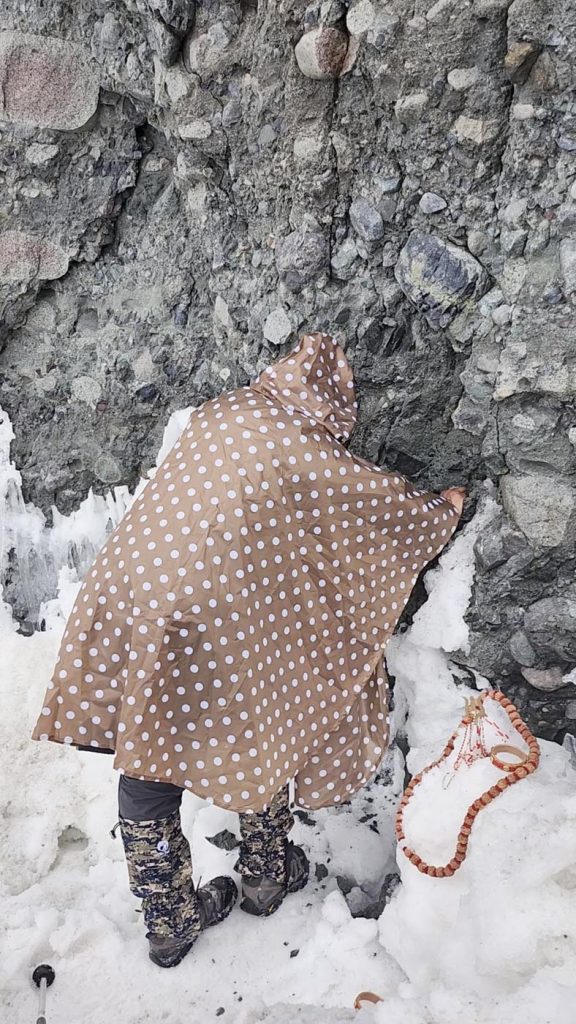
I turned back, thanked the kind crew with a smile for giving me privacy and not rushing what was an experience of a lifetime before heading back. It would be another four hours of trekking at the minimum, but my heart was full with the realization that every day now was a gift from Siva.
Day Three
The next morning before dawn, we started our hike. It would be the most challenging leg—about 14 miles, longer than the first two days combined. The first several miles would be the hardest, ascending to Dolma La Pass, at an elevation of over 18,400 feet. Many yatris had opted to continue on pony after the strenuous hike the previous day. I was daunted and weakly resolute, and tried to focus on the scenery around me.
The trail was narrow, relentlessly winding its way through boulders placed on a carpet of dull green grass. The wind whistled continuously and blew without restraint over the dry and barren landscape. My breathing got harder and noisier with every step, and I could do no more than a few at a time. It had barely been an hour since we started. I felt something warm on my face and recognized my tears streaming down, bearing testament to my helplessness. Desolation was beginning to spread and draw in on what little energy I had remaining. I could blame no one for this trip as it was entirely my decision. I looked at Kailash in anguish, wondering what more I needed to offer to complete this journey. Clearly, the mountain and its natural environment was much bigger than I am.
As if understanding, Mani handed me my thermos of hot water that I sipped quietly. An elderly Tibetan gentleman came up, paused, flashed his toothless smile and gave me a thumbs up. We couldn’t speak each other’s languages, but his intention could be sussed out from his weathered, wrinkled, enquiring smile checking on my comfort. I smiled back. Maybe my surrender wasn’t complete, so after I returned my thermos, I held my hand towards Mani. He understood and pulled me up for the next steps. After that I fell into a rhythm of being led by him on most of the harder sections. Looking back, I wonder if, after years of conditioning as a self-proclaimed modern woman, I had forgotten humility and frowned upon seeking help when I needed. Perhaps I still valued my successes as my own, not paying homage to the invisible hands that supported me. I wouldn’t know the answer with any degree of certainty.
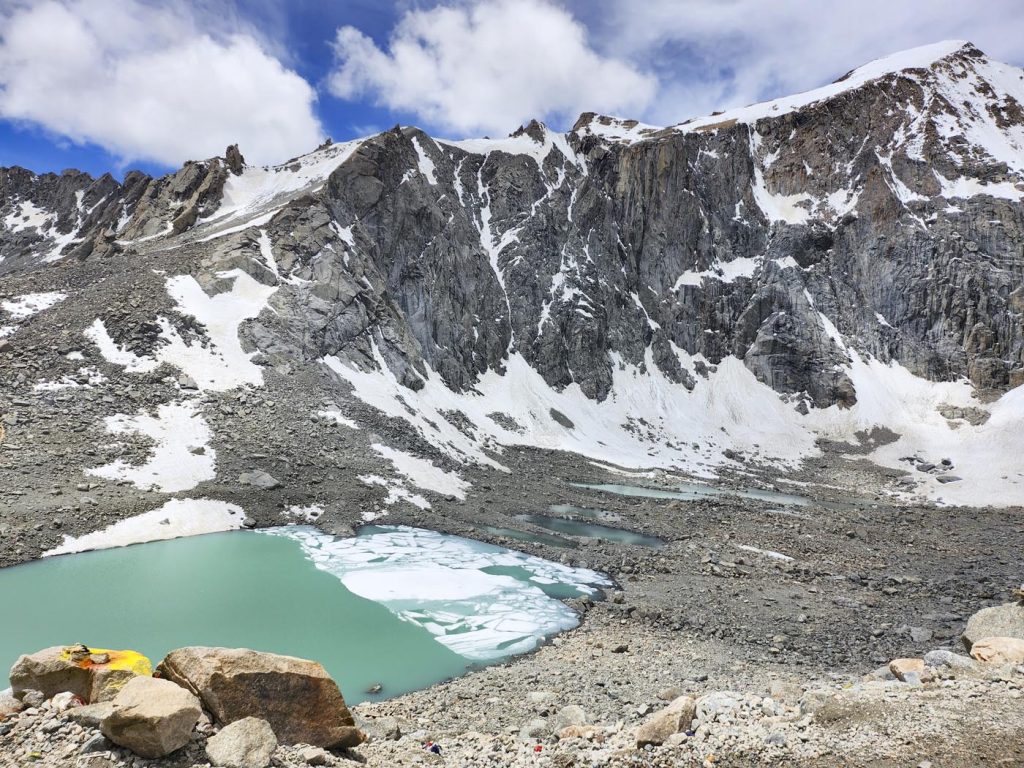
After several hours we reached Dolma La Pass, the highest point in our parikrama. The ground was covered with a carpet of prayer flags. I saw several Tibetans gazing in respect and solemnity at the embossed messages and pictures around them. Mani let me stay long enough for some photographs before ushering me on, as it was dangerous to be exposed for long to such altitudes. We quickly made a steep descent through some very narrow rocky passages. I was worried about slipping and hurting my ankle, but internally relieved that from now on it would be easier on the lungs. Shortly, we encountered a stunning emerald-blue lake (above), covered partly in ice. It stood out in that environment, looking ethereal and inviting. We had reached Gauri Kund, the private bath of Goddess Parvati where she created Ganesha from the sandalwood paste scrubbed out of her body. With around ten miles of trekking left, I was unwilling to take more risks, so I handed my bottle to Mani to climb down to fill with the lake’s waters.

After a break, we continued to cross streams and open fields onto the main road. By now we had the comfort of greenery, trees and yaks grazing languidly on the fields. This change in scenery raked in new outcrops of optimism, helping me forget the strain of the last few days. Rain came down in spurts, darkness slowly crept in and the roads became increasingly isolated, separated by an occasional tent or ramshackle farmhouse. Mani was worried that I was getting exhausted and asked if I wanted to rest in a neighboring house. I shook my head. Just as we began wondering if we had lost our way, we came upon the familiar face of a yatri who had journeyed back to check on us, based on our attempts to reach the staff. After nearly 13 hours of walking, I finally bounded into the warm interior of our dormitory in Zuthulphuk, greeted by the kind hospitality of the staff and a pot of hot soup.
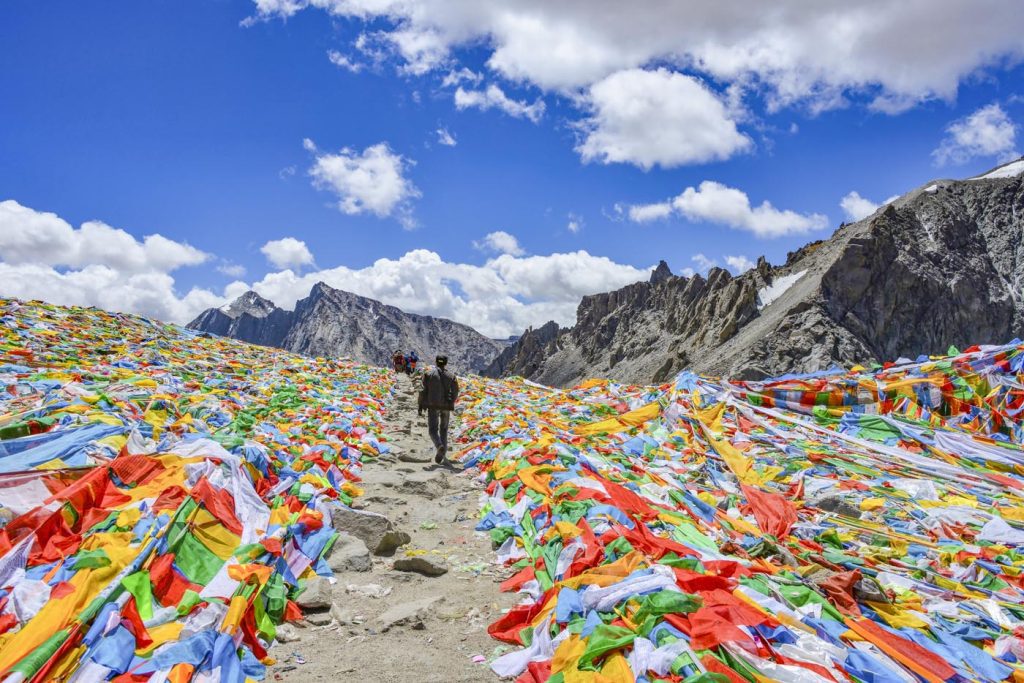
Day Four
On the last day of the parikrama, we started trekking in the dark shortly after 5 am. I was very relaxed, as today would require only a few hours of exertion to reach Darchen. There, we would board a bus towards Saga, with a stopover by the river Brahmaputra.
It was an easy amble until Mani quickly stopped and held my pole. We were on a narrow ridge, and my headlamp revealed a line of Tibetan devotees executing full-body prostrations in its cavity with no light to guide them. Hands folded in the lotus mudra, they touched the crown on their head, throat and chest and then dropped their body to the ground. Then pulling themselves up, these practitioners of Vajrayana Buddhism ritualistically purified their bodies by paying homage to Gang Rinpoche. This is a common sight throughout the parikrama where Tibetans, even young children, with only aprons and gloves over their attire, would dispense with their karmic accruals by subjecting themselves to this rigorous pilgrimage. When they got tired, they would roll over where they were and rest. What would take them a day by walk would stretch by several weeks if they prostrated at every step. Mani assisted me up above the ridge and we continued.
As dawn broke over the horizon, I joined other yatris walking towards where our bus awaited. We hadn’t seen the mountain at all today, so I asked in which direction Mt. Kailash lay, and prostrated on the ground. I may never see it again, but I couldn’t leave without thanking Siva wholeheartedly for this opportunity for me to come to Him. Turning around, I thanked Mani who was instrumental in helping me complete the pilgrimage. My words were limited but I hope he understood their sincerity.
Stopping by a hotel for breakfast, I finally called my family. I had cut contact with them for four days so my resolve for completing the parikrama by foot would not be shaken. I would soon share their secure embrace as I returned to the comfort of my world.
Conclusion
Mt. Kailash provides the perfect foil for someone seeking silence or purpose. It may have the trappings of an adventure, but it is not a routine mountaineering experience. It is a pilgrimage inwards to tap into a little bit of the divinity within ourselves. A pilgrimage such as this is meant to be physically hard, so we exhaust, empty ourselves intentionally and work on our internal growth. For those who wish to visit it at least once, I hope you are able to go early, as this is a physically demanding trip. For those who greatly desired but were unable to make it, I hope my writing and pictures were able to convey the character of this yatra. While this journey demands a confluence of money, fitness, opportunity and a deep longing, the most essential ingredient, in my humble opinion, is that of surrender: humbling oneself before the vast expanse of nature, humbling oneself before Siva so He may bear the responsibility of every step.
About the author
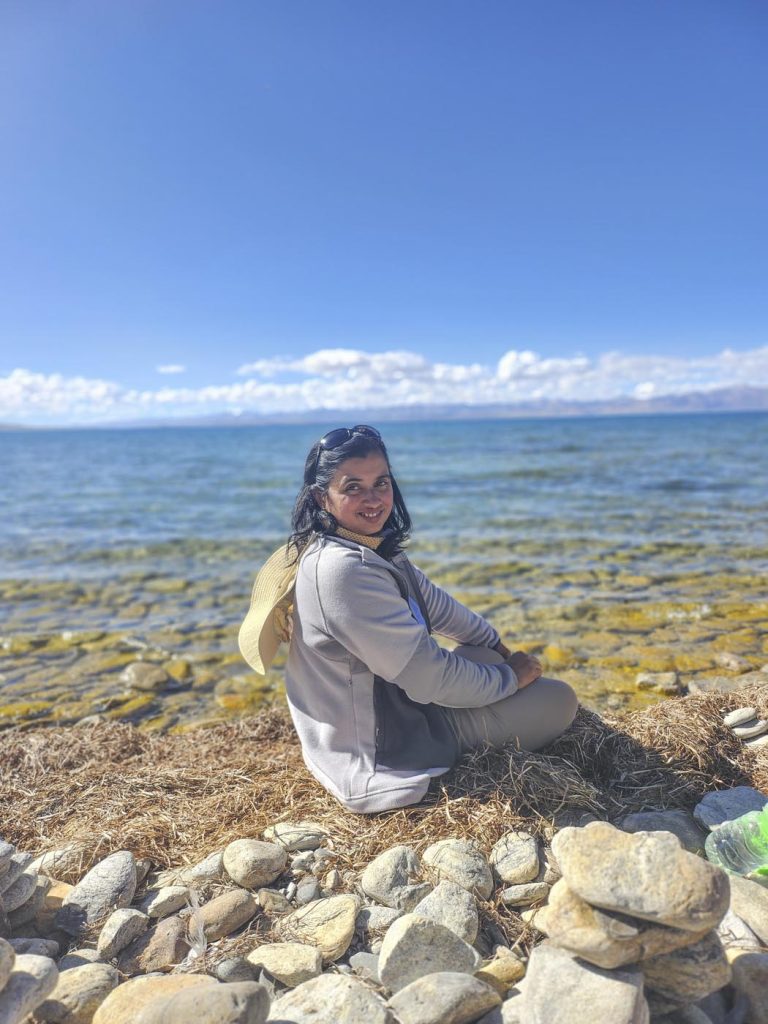
Vidya Mohan lives in Washington with her husband and two children. She loves walks, books and painting with acrylic. Her blogs can be found at garudabooks.com/blog/ and on her own website,
antarprayanam.wordpress.com. Contact her at X/@moh_vidya/ or Instagram/@antarprayanam
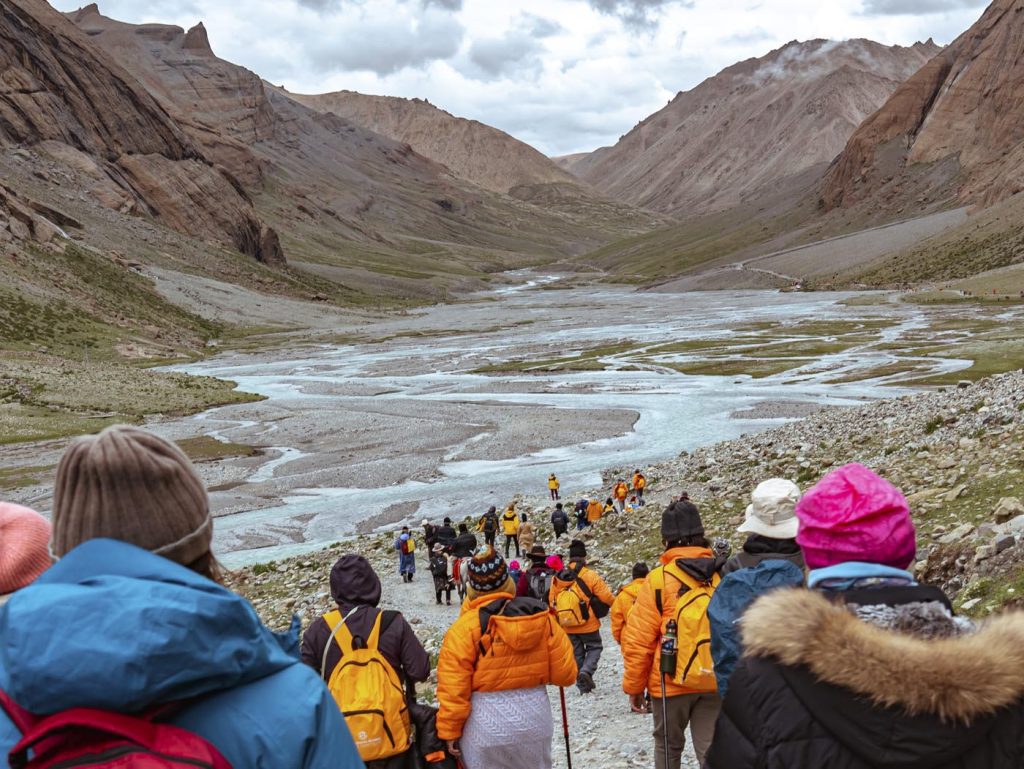
My name is Mukesh Vyas, who was with Vidya during this Parikrama but unfortunately due to sever health and breathing condition, I could not complete Parikrama but after reading this Vidya’s detailed experience article, I feel that I had completed the Parikrama. Some of feelings, Vidya had represent in her article , we realize after reading this. I had realization of some Devine power and energy when I felt down from horse and feel like someone is holding me and not a single scratch, I was saved and continued further Parikrama after that realization.